
----------------------------------------------------------------------------------------
----------------------------------------------------------------------------------------
?KIA = ZOS!
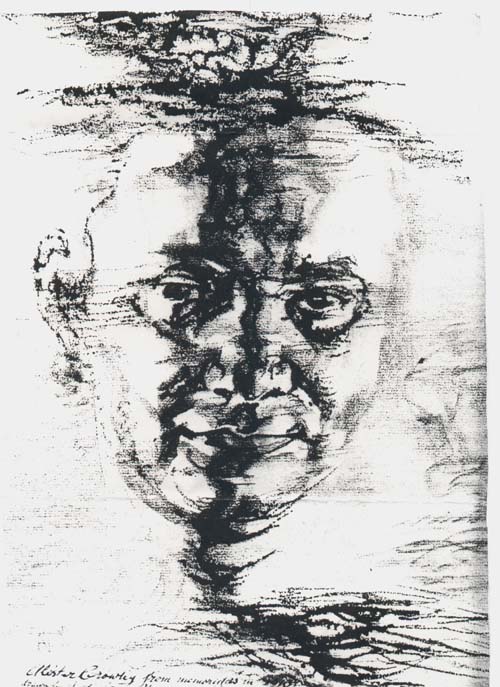 Aleister Crowley by Austin Osman Spare
Aleister Crowley by Austin Osman Spare
"At no time in my life have I been a person to hold myself polluted by the touch, habits or approach of any creature other than those who were human shape." - Austin Osman Spare, c.1945
From around 1907, when Spare's art exhibits caught the eye of Aleister Crowley, until when Crowley dismissed Spare from membership in the order Argentum Astrum, Crowley's own introductory Order to Mather's older Golden Dawn, for being a "Black Brother" of the "Left hand path," is all the more mention of correspondence between these two great Magi, yet their philosophies would irrevocably change the world. Crowley's Aeonic mysteries ushered the "New Age" of "Aquarius," while Spare's surrelaistic art would influence Kenneth Grant, another pupil of Crowley's, to lay the foundations of modernday Chaos Magick.
I first encountered Spare from a friend of mine who is an exuberant and enthusiastic researcher into the works of both Spare and Grant. In our initial conversation, I somehow got the idea that he suspected, but did not think it wise to say outright, that Kenneth and Steffi Grant had only offered patronage to Spare to stear his work more in the direction of art and away from the direction of his writings. At the time of Ethos, which is the work of Spare's I will be addressing in a moment, Spare was already a brilliant, if style-wise confused, philosophical authour. His existential quandries top Sartre's nausea and he explains the very real, Magickal science behind Edmund Husserl's Epoché (where one observes an object until all its external referential meanings are removed and it is revealed in its pure essence, a subjective substance of pure being).
If Kenneth Grant did stear his friend Austin Spare away from writing and into the increasingly deranged world of the starving artist, it was only to serve his own best intentions, for Kenneth Grant is now widely considered the God-father of modern Chaos Magick, and is, in truth, a barely even mediocre writer. In recent years he has expressed some Theosophical reperatory leanings, collecting the writings of modern eastern Gurus from their sources directly rather than attributing his core research simply to "eastern Mahattmahs," trance-channeled "Ascended Masters" and the like. Don't get me wrong, Kenneth Grant's writings are fascinating, if you are particularly interested in the psychological effects of ingesting menstruation (Star Fire, the "Witches'" or "Black Sabbath").
Spare was quite the cloistered Pantheist in his life, producing two full sketchbooks full of twisted and perverted looking Satyrs, goat-men and images of Pan as an attempt to repress the desire for recognition of his psychological input from the left hemisphere of his own brain. But I am getting ahead of myself. Spare, himself, was something of a bipolar manic-depressive, prior, of course, to any sort of effective treatment for his rapid-cycling mood disorder, still at that time diagnosed as "melancholy" and "weakness of the spleen" and treated with a strong cocain tonic.
He was also quite a cloistered idealist about a specific romance in his own life, a witch from Salem Village whose married name was Mrs. Paterson, according to Spare's writings in later life, only recently released by Grant. It was most probably her who had introduced Spare to the occult first, and much of his art-work tends to directly indicate knowledge of probably Turkish hashish and opium cults in England, such as that of the "Peacock Angel" of the initiatory Yezidi converts of that particular time and place. These such cults were often sources for aspiring artists and other do-gooder urchin-types to inculcate into the hierarchical "pecking order" of the occult underworld, and it was most likely by connections made in an opium den that Spare secured the art show that put him in contact with Crowley.
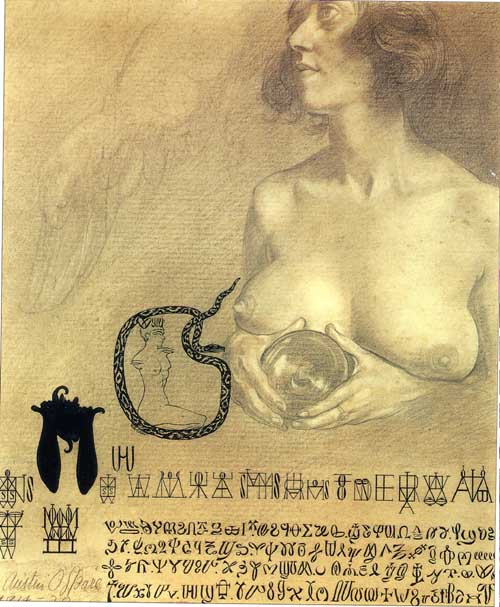 AOSpare: "the death posture" (from Ethos)
AOSpare: "the death posture" (from Ethos)
Spare refers to the works in Ethos, the work I will comment on here, as some of his "first... automatic drawing." His commentaries on automatic art techniques rival Dali, Master Craftsman of "each of the five different movements corresponding to each of the five different types of brushes," and is even somewhat prescient of Roland Barthes copious commentary of a similar sentiment toward the text of writing itself. Spare describes "art as 'Need-Not-Be,'" and "the Vital Religion," saying, "the virtue of art is that it can contradict (any law of) Science." This, as we shall see does most of Spare's work, fits in quite nicely with Crowley's Law of Thelema, obviously why Grant would want to use Spare as leverage against rivals within the early Typhonian OTO. Remember that the slogan of the OTO, printed on every Equinox, states: "We place no reliance on virgin or pidgeon. Our method is science, our aim is religion."
Spare himself describes the "duality" symbol, similar in appearance to a celtic heart motif, given as:  , as representative of the concept he calls "Kia" or "Thou art 'that,'" meaning the unshakeable sense of self. Other symbols Spare uses for Kia are the vulture's head, the "eye of Horus," "ka" and "djed pillar" Egyptian hieroglyphics.
, as representative of the concept he calls "Kia" or "Thou art 'that,'" meaning the unshakeable sense of self. Other symbols Spare uses for Kia are the vulture's head, the "eye of Horus," "ka" and "djed pillar" Egyptian hieroglyphics.
When Kia, the "unconscious ego," is raised to self-awareness, Spare qualifies this level as "Zos," although a QBLHist would know it as Ruach and a psychologist as the subconsciousness. Spare goes on at great length about "the Dwellers on the Threshold" of the subconscious, whom he also calls "the Dwellers at the Gates of Silent Memory," and I will return to them in a moment.
The third level above both Zos and Kia is Thanatos, the Greek God of death, equivalent in the minds of the subsequent Chaos Magick researchers to Typhon, the Greek name for Set or Apophis, the serpent god of Egyptian mythology, who betrayed and murdered Osiris. The alphabet of symbols and phonic of images Spare associates around Thanatos are "the Death Posture," the depiction of the right hand, and the "Neither-Neither" process that Spare describes as, "you are fire - yet you are scorched."
Essentially, Spare's esoteric ontology is the Trinity, but there is a significant difference between Spare's Trinity and the "benign and benevolent" Trinity of Catholicism. The attribute Spare associates with the term "Kia" is actually equivalent not to the bodily self (the Kha), but the psychological "double" or the "second-self" (the Ka).
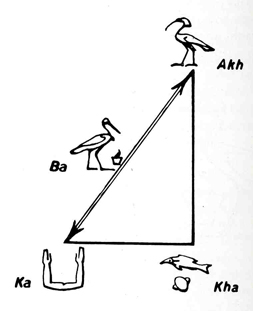
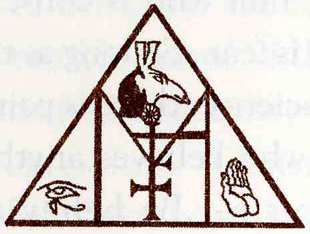 (left) the composition of the spiritual-self according to the Egyptians, with the Ka (Kia) or "double" on the lower left.
(right) Set or Anubis, the left eye and left hand, Austin Spare (from Ethos)
(left) the composition of the spiritual-self according to the Egyptians, with the Ka (Kia) or "double" on the lower left.
(right) Set or Anubis, the left eye and left hand, Austin Spare (from Ethos)
----------------------------------------------------------------------------------------
Projection
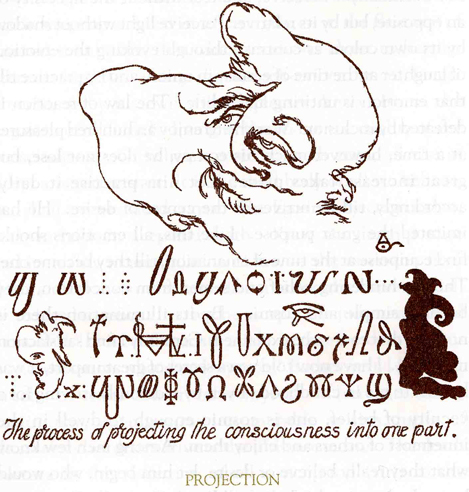
Now, essentially what we are breaking this picture down to is above and below the limit of a horizon. Above, the hand symbolises right-hemispherical creativity as a metamorphosis of the method or media of expression with the notion of the self (or Kia). Below, the alternating sigils and "sacred alphbet" letters actually have a few real Geomantic signs. On the right is one of Spare's "dwellers on the threshold," who will always be depicted throughout this period of Spare's art as silhouettes. We see also the eye of Ra among the imaginary glyphs, but here this only represents Kia, or the "double." On the left, across from the silhouetted servitor, Spare has rendered a more joyfoul and less shy excrescence of pure being in itself as a transitional between the silhouetted, dark "dweller on the threshold" and the purely creative and completely informal gestural automatic expresion of the self into the hand as an extension of projection. Thus, completed in this progressive (rather than cyclical) Trinity between Kia (the silhouette), Zos (Zeir Anpin), and Thantos (the mutated hand/face in the upper half). All in all that was a fairly simple one to start on. So now let's look at another.
----------------------------------------------------------------------------------------
Preliminary Death Posture
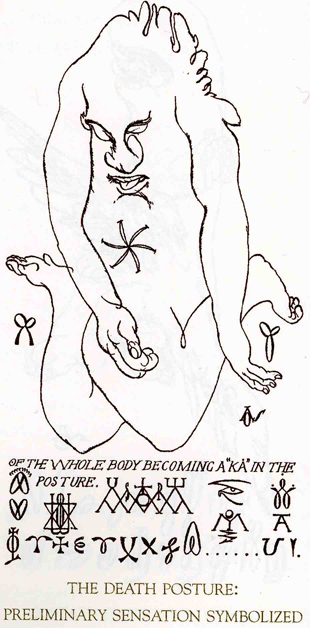
Here we see Spare specifically refering to his Kia concept as the Ka, that is, the metaphysical double. However, remember that, by this he merely means the lesser self, or rather, the duality inherent in manifest, material reality. Spare says, quite to the point, that, "him who has (even symbolically) for a moment by the "Neither-Neither" conquered the dual principle (Conception), his ego is free from gravity." Here we see the dual "heart-like" glyph for Kia reflected one above and one below, the eye of Horus, and an interesting sextuple "wheel" of "the sun." The meaning of the "Death Posture" itself is clear: that, from spiritual exertion unabated in utterly and absolute abandon, the mortal body (that being the Kia, or leeast-self in Spare's cosmogoguey) has collapsed down upon itself and shrunk inward upon itself. The effect would be somewhat similar to having the spirit entirely drained from the vessel of the flesh in a metaphysical orgasm and leaving the shrinking skin to wrinkle down onto the dust.
----------------------------------------------------------------------------------------
Death Posture
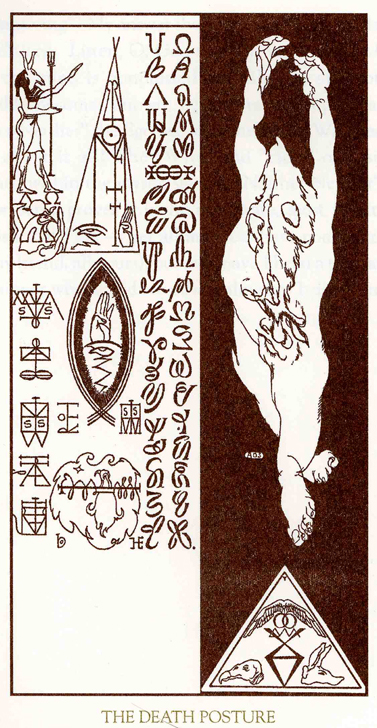
This picture is divided essentially identically to the Porjection piece, however oriented dorsally instead of laterally. This is, of course, the left and right hemispheres of the brain again. The left side (black on white) is the logical and rational, strategic side. The right side (white on black) is the creative and intutive, insightful side. So let us look first at the left side, then at the right side.
In the upper left corner of what starts out to be an Egyptian stele is Harpocrates, Arich Anpin (the long-faced), crowned with the crokked raised arms of the Ka glyph. We see Harpocrates astride an ALPHA on one foot and an OMEGA on the other. Below this is Horus, adorned with the ram horn-like crown of upper Egypt and the solar disc and striking serpent of lower Egypt. Beneath Horus, in an unusually subordinate role here, is the arched back of Nuit, the arcing night of the universe. To the right of this we see the weighing of the soul depicted in a symbolic glyph, with the Kia eye and Zos hand opposed like the heart and the feather. Below this the hand-motif repeats, but with the little-finger extended, indicating the primacy of the three other fingers. Below this an eye peaking through a crack in a cosmic egg, that, itself, follows the path of the flaming sword and the blind dragon. To the left, Spare experiments with engligh letter servitor glyphs using rhombi. In the lowest middle is a demi-art glyph, invoking a more unknown or unaware of force, and thus considered rudimentarily evil. Along the right side of the left half Spare's unique "sacred alphabet" of imaginary unilinear letters convey as-of-yet unknown mental meanings beyond their immediate appearance.
On the right side, the dark, male, Yin, creative and passive side, there are only two elements. One of them is the Alchemical Crucifixion of Pan. We see the strange body of the cherub floating in the void as if in suspended animation, but we can barely understand the strange skull-mask the head wears, let alone even begin to make out its bold phallus to compliment immediately opposite the 3-band yonic vesica in the left hemisphere. However this, it would seem to be implied to mean, is how the strangely suppressed role of our more emotionally open and ownership indifferent side is meant to be perceieved to us at this point in history. Beneath the feet of Pan, Spare has penned another triangular design indicating the relationship of Kia, Zos and Thantos, similar to the one compared to the Egyptian orientation of the parts of the soul given above.
----------------------------------------------------------------------------------------
Unlabeled
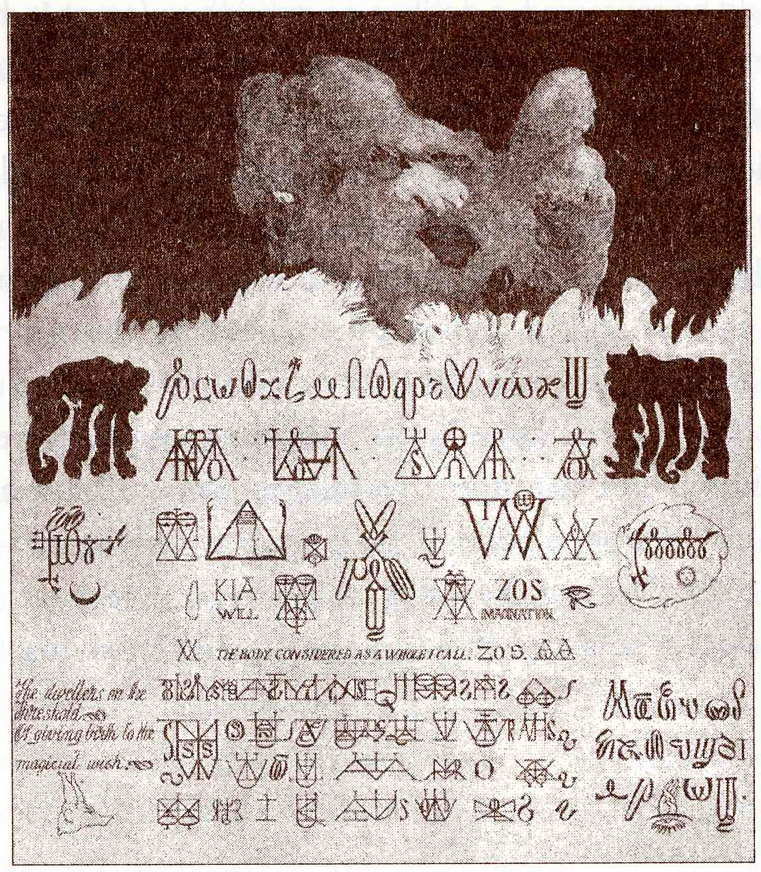
Whether it is called the difference between Jechidah and Chiah from the Nefesh, Ruach and Neschamah, or whether it is called the Trinity of God the father, Christ the son and the Holy Ghost of consiousness, or whether it is called the super-ego of the conscience or true will over the unconscious instincts of the lesser will or animal id, or whether it is called Being en-soi opposed to being por-soi and the implication of Otherness, it all amounts to the same thing: the division or duality between reality and the ideal is an illusion of unknowing caused by the presence only of our own perception. We can call our own effect on reality the Abyss, the Qliphoth, quanta, Uncertainty, Chaos, our Holy Guardian Angel, Thelema, the Shekinah of God, but ultimately it is ineffable and indescribable so long as it exists autonomously alienated enough from itself to be able to attempt to describe itself as simultaneously within and exterior to itself. Self-awareness is a contradiction in terms, for the self exists only so long as it is aware of itself. We cause ourselves to exist by our consciousness and we leave our self-centred ego behind us when we transcend the mundane in the exact same way as our physical body literally dies when the consciousness no longer inhabits it.
-ben
----------------------------------------------------------------------------------------
----------------------------------------------------------------------------------------
